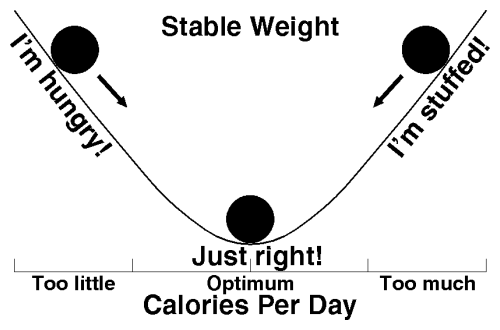
Consider Skinny Sam, that exasperating acquaintance we all seem to have: the fellow who's never overweight, never out of shape, who chows down whenever he feels like and eats as much as he wants, who can't understand how anybody could have a weight problem. How does he do it?
Well, now we know. Sam is fortunate enough to possess a mechanism you and I lack: a proportional negative feedback linkage between his body's need for calories and his appetite for food. His feedback system works like this.

This graph is identical to the one describing a
proportional control thermostat; compare it with the chart on page
![]() . The mechanism is identical, only the
labels have been changed to reflect the incidents. Rather than
temperature, what's being controlled is the number of calories of food
eaten. Rather than switching on a furnace or air conditioner, control
is accomplished through a signal called appetite. The effect is
the same.
. The mechanism is identical, only the
labels have been changed to reflect the incidents. Rather than
temperature, what's being controlled is the number of calories of food
eaten. Rather than switching on a furnace or air conditioner, control
is accomplished through a signal called appetite. The effect is
the same.
When Sam eats the same number of calories as he burns, the ball rests at the bottom of the bowl and his appetite is silent. If less food goes in than he burns, whether from skipping meals, eating less at each meal, or from the extra calories he burns up practicing wolverine juggling three times a week, the ball drifts to the left. As it does, his appetite begins to signal, subtly at first then with increasing stridency, the need for more food. Conversely, when too many working lunches become rounds of ``eat fast or get the anchovies''; when Sunday afternoon touch football in the back yard is supplanted by Monday Night Football in front of the illuminatus, too many calories begin to push the ball to the right. ``How can you think of food?'', groans Sam. ``You guys enjoy your burgers. All I want is a stalk of celery and a good night's sleep!''
By John Walker